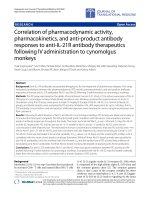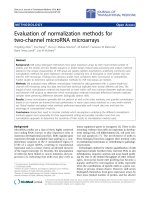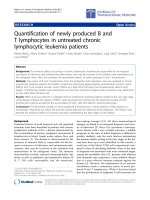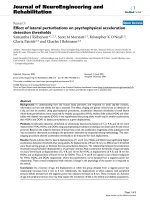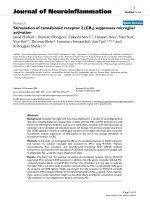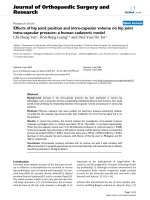Báo cáo hóa học: " Fabrication of core/shell ZnWO4/carbon nanorods and their Li electroactivity" ppt
Bạn đang xem bản rút gọn của tài liệu. Xem và tải ngay bản đầy đủ của tài liệu tại đây (742.96 KB, 7 trang )
NANO EXPRESS Open Access
Fabrication of core/shell ZnWO
4
/carbon nanorods
and their Li electroactivity
Hyun-Woo Shim
1
, Ah-Hyeon Lim
1
, Gwang-Hee Lee
1
, Hang-Chul Jung
1,2
and Dong-Wan Kim
1*
Abstract
Carbon-coated ZnWO
4
[C-ZW] nanorods with a one-dimensional core/shell structure were synthesised using
hydrothermally prepared ZnWO
4
and malic acid as precursors. The effects of the carbon coating on the ZnWO
4
nanorods are investigated by thermogravimetry, high-resolution transmission electron microscopy, and Raman
spectroscopy. The coating layer was found to be in uniform thickness of approximately 3 nm. Moreover, the D and
G bands of carbon were clearly observed at around 1,350 and 1,600 cm
-1
, respectively, in the Raman spectra of the
C-ZW nanorods. Furthermore, lithium electroactivities of the C-ZW nanorods were evaluated using cyclic
voltammetry and galvanostatic cycling. In particular, the formed C-ZW nanorods exhibited excellent
electrochemical performances, with rate capabilities better than those of bare ZnWO
4
nanorods at different current
rates, as well as a coulombic efficiency exceeding 98%. The specific capacity of the C-ZW nanorods maintained
itself at approximately 170 mAh g
-1
, even at a high current rate of 3 C, which is much higher than pure ZnWO
4
nanorods.
Introduction
Since Poizot et al. reported that select transition metal-
based oxides exhibit high capacities [1], new anode
materials based on metal oxides have been extensively
studied [2,3] as promising alternatives to carbon-based
materials used as anode materials in commercial Li-ion
batteries [LIBs]. However, in spite of all the research,
some challenges to overcome still remain, such as large
volume changes during Li
+
insertion and extraction.
Tailoring nanostructures is one popular approach for
improving the electrochemical performance of these
materials, such as cyclic retention and rate capability
[4,5]. Thus far, considerable efforts have b een devoted
to overcome these problems by using the active/inactive
composite concepts, including core-shell nanostructures,
in which the inactive phase serves as a buffer and partly
alleviates mechanical stress caused by the volume
change of the active phase [6,7]. Carbon coating can be
also derived from this concept because carbon materials
are often of low activity. Numerous previous studies
have demonstrated carbon coating as an effe ctive route
to improve the electrochemical performance of metal
oxide-based anode materials for LIBs. However, most of
the previous methods for producing carbon-coated
materials were limited, using glucose and sucrose as car-
bon precursors to obtain the carbon-rich polysaccharide,
as well as relatively complicated [8-10].
Recently, Hassan et al. [11] have reported carbon-
coated MoO
3
nanobelts using malic acid as a new car-
bon source. However, other metal oxide-based materials
for application to anodes of LIBs are rarely reported
although the met hod of carbon coating using malic ac id
has been published. Herein, the authors report on a sim-
ple preparation of one-dimensional core/s hell ZnWO
4
nanorods with homogeneous carbon coating and their
enhanced electrochemical performance versus that of
lithium as a new anode material for LIBs. Furthermo re,
when used as anode m aterials in LIBs, the carbon-
coated ZnWO
4
nanorods exhibited significantl y
improved rate capabilities when compared to pure
ZnWO
4
nanorods. The result demonstrates that a suita-
ble carbon coating is a n effective strategy to improve
the rate capabilities of the oxi de-based anode materials
in LIBs. From a survey of the literature, this is the first
report on carbon-coated ZnWO
4
nanorods.
* Correspondence:
1
Department of Materials Science and Engineering, Ajou University, Suwon
443-749, South Korea
Full list of author information is available at the end of the article
Shim et al. Nanoscale Research Letters 2012, 7:9
/>© 2012 Shim et al; licensee Springer. This is an Open Acc ess arti cle distributed unde r the terms of the Creative Commons Attr ibution
License ( which permits unrestricted use, distributi on, and reproduction in any medium,
provided the original work is properly cited.
Experimental details
Carbon-coated ZnWO
4
nanorods were achieved in two
stages: first, ZnWO
4
nanorods as core parts were pre-
pared using a hydrothermal process with adjusting pH
values at 180°C for 12 h; this was followed by general
washing and drying steps. Zinc nitrate hexahydrate (Zn
(NO
3
)
2
·6H
2
O, 15 mM, 99.0%, Aldrich Chemicals, St.
Louis, MO, USA) and an equal amount of sodium tung-
state dehydrate (Na
2
WO
4
·2H
2
O, 15 mM, 99.0%, High
Purity Chemicals, Tarapur, Maharashtra, India) were
used as starting materials. The ZnWO
4
nanorods thus
obtained were then coated with carbon. Malic acid
(C
4
H
6
O
5
, 99.0%, Aldrich Chemicals, St. Louis, MO,
USA) was used as the carbon source. The malic acid
was first dispersed in toluene (C
7
H
8
, 99.5%, Alfa Chemi-
cals, Berkshire, UK), and the ZnWO
4
nanorods obtained
from the hydrothermal technique were added to toluene
while stirring at room temperature for 2 h. Subse-
quently, the slurry was dried at 120°C for 4 h and then
180°C for 6 h under vacuum.
The weight fraction of the coated carbon was deter-
mined by thermogravimetric analysis [TGA] (model
DTG-60 H, Shimadzu, Kyoto, Japan). The crystalline
phase of the prepared samples was carried out using
powder X-ray diffraction [XRD] (model D/max-2500 V/
PC, Rigaku, Tokyo, Japan), and the distinct propertie s of
the carbon-coated sample were confirmed within the
wavelength range of 1,250 to 1,650 cm
-1
using laser
Raman spectrometry (spectrometer model SPEX-1403,
SPEX, Seoul, South Korea). The microstructures of the
carbon-coated samples were examined using transmis-
sion electron microscopy [TEM] (model JEM-2100F,
JEOL, Tokyo, Japan). High-resolution transmission
microscopy [HRTEM] was performed for further sample
analysis. The electrochemical performance of the sam-
ples versus that of lithium was measured by means of a
multichannel potentiostati c/galvanostatic system (model
WBCS 3000, WonATech, Seoul, South Korea). All sam-
ples were galvanostatically cycled as anodes and
recorded in a voltage window between 0.01 and 3.0 V.
Results and disc ussions
The obtained powder of 10 wt.% carbon-loaded ZnWO
4
became dark grey due to the uniform coating. To deter-
mine an exact amount of the carbon content in the car-
bon-coated ZnWO
4
[C-ZW] nanorods, TGA in air was
executed. As shown in Figure 1, the first minor weight-
loss step in the tempe rature range up to 200°C, corre-
sponding to the removal of H
2
O absorbed onto the pro-
ducts, indicated a weight loss of approximately 1% to
2% in all samples prepared in this work. Importantly,
the C-ZW nanorods subsequently revealed the highest
weight-loss step, but pure ZnWO
4
[pure ZW] nanorods
showed a negligible change in weight loss. These results
indicate that combustion of malic acid in the C-ZW
nanorods occurred. The combustion reaction begins
near 250°C and is completed at approximately 500°C.
According to the TGA curves, the c arbon content in
the product is about 10% after heat treatment of up to
700°C.
Figure 2 shows the XRD patterns of the as-pr epared
pure ZW and obtained C-ZW nanorods. All the reflec-
tion peaks of the samples were completely indexed as a
highly crystalline, monoclinic, wolframite-tungstate
structure, and were in good agreement with the litera-
ture values (JCPDS file no.: 88-0251, space group: P2/c)
for ZnWO
4
[12]. No secondary phase other than
ZnWO
4
was d etected in any of the products, indicating
that the samples obtained were single-phase materials.
In particular, as can be seen on the C-ZW nanorod
sample, no carbon peak was identified from the XRD
pattern. The carbon was hard to detect by XRD analysis,
possibly due to its amorphous nature.
In order to clearly confirm a distinct characteristic of
carbon properties within the C-ZW nanorods, we inves-
tigated the Raman spectra of both the pure ZW and C-
ZWnanorods.Figure3ashowstherepresentative
Raman signals (123, 146, 164, 195, 275, 314, 343, 407,
514, 545, 677, 708, 785, and 906 cm
-1
) related to the
ZnWO
4
structure. In particular, the presence of six
vibration modes of A
g
a
and B
g
a
(a = internal stretching
modes) should be noted as an important property of
monoclinic wolframite ZnWO
4
; the vibration modes
arise from the six internal stretching modes caused by
each of the six W-O bonds in the WO
6
octahedrons. In
the case of Raman analysis, group theory analysis of
wolframite-type ZnWO
4
predicts 36 lattice modes, of
which 18 even vibrations (8A
g
+ 10B
g
) are Raman active
[13]. Although all 18 vibration modes were not observed
in this Raman spectra, 13 vibration modes were identi-
fied exactly, in comparison with previous reports [14,15].
More importantly, the Raman analysis results can con-
firm the presence of carbon lo ading in the C-ZW
nanorod samples. As depicted in Figure 3b, the spec-
trum of the C-ZW nanorods in the wavelength range of
1,250 to 1 ,650 cm
-1
, which is magnified from the dash
box in Figure 3a, ex hibi ted obvious differences from the
pure ZW nanorods. The peaks indexed by black arrows
at approximately 1,370 and 1,580 cm
-1
are related to
carbon, which are designated in terms of D and G
bands. These peaks are in good correspondence with
the Raman spectra of the amorphous carbon reported in
the literature [16-18].
The TEM observation more clearly demonstrated the
success or failure of carbon coating on the C-ZW
nanorods.Figures4a,bshow the representative TEM
images of the C-ZW nanorods. The obtained morphol-
ogy of the C-ZW nanorods still maintained the original
Shim et al. Nanoscale Research Letters 2012, 7:9
/>Page 2 of 7
properties of pure ZW nanorods (core parts) without
any visible change. In particular, as expected, from the
high-magnification TEM image (Figure 4b), w e can
observe the carbon layers (shell parts) surrounding the
C-ZW nanorods. Moreover, the C-ZW nanorods possess
an average diameter of nearly 40 nm and length of 120
to 260 nm, which indicate a relativel y large size com-
pared to the pure ZW nanorods.
To further confirm the carbon coating on the surface
of ZnWO
4
nanorods, C-ZW nanorods w ere studied
using TEM, as shown in Figure 4. The C-ZW nanorods
obviously sustained the original, rod-like morphology of
pure ZW (Figure 4 a). A thin carbon layer was homoge-
neously coated onto the surface of each pure ZW (Fig-
ures 4b, c), without deposition of isolated carbon islands
by excess carbon pile-up. This resulted in the formation
of a hybrid ZnWO
4
/carbon core/shell structure (inset of
Figure 4c). The uniform thickness of carbon was
approximately 3 nm, based on the HRTEM images (Fig-
ures 4d, e) of the individual nanorod, which was taken
from the open-square regions in Figure 4c. The surface
of the core ZnWO
4
was very clear and clean, and the
magnif ied view shows the highly crystalline structure of
the ZnWO
4
[19,20]. In Figure 4e, the C-ZW nanorods
were structurally uniform, with interplanar spacing of
roughly 0.468, 0.362, and 0.284 nm, corresponding to
the (100), (110), and (020) lattice spacings of the
ZnWO
4
structure. In addition, the indexed selected area
electron diffraction [SAE D] pattern via the <00 1> zone
axis revealed the single-crystal nature of the nanorods
and further confirmed preferential growth along the
[100] direction of the nanorod structures (Figure 4f), as
previously reported in the hydrothermal synthesis of
pure ZW nanorods [12]. As a result, such uniform car-
bon loading on ZnWO
4
is expected to improve the elec-
tronic conductivity and electrochemical performance of
the pure ZW nanorods.
Figure 5 shows the electrochemical performance as
cycling behaviours of the C-ZW and pure ZW nanorod
electrodes cycled at different current rates. The cells
were first cycled at a current rate of 0.1 C, and after
every 10 cycles, the current rate was increased in stages
to 3 C. The last 10 cycles proceeded at a current rate of
0.2 C. As predicted, the C-ZW nanorod electrodes
Figure 1 TGA of pure ZW and C-ZW nanorods. (By HW Shim et al.).
Shim et al. Nanoscale Research Letters 2012, 7:9
/>Page 3 of 7
exhibited superior rate capabilities compared to pure ZW
nanorod elec trodes. In particular, at the end of rates 0.1,
0.2, 0.3, 0.5, 1, 2, and 3 C, the C-ZW nanorod electrodes
delivered specific capaci ties of 512, 389, 340, 300, 252,
201, and 169 mAh g
-1
, respectively, while maintaining an
excellent coulombic efficiency greater than 98%. Even the
specific capacity at a current rate as high as 3 C
approached 170 mAh g
-1
, roughly three t imes higher
than that of pure ZW nanorod electrodes. We thus con-
tend that these results can be attributed to the beneficial
effects of carbon coating, which enable efficient electro-
nic conductivity and prevent volume expansion during
Li-ion insertion and extraction processes.
Conclusion
In summary, we have demons trated the synthesis of
carbon-coated ZnWO
4
nanorods with a one- dimen-
sional core/shell structure using a simple hydrothermal
route and subsequent carbon coating, and their
enhanced Li-storage performance compared with pure
ZW nanorods. The uniform loading of amorphous car-
bon onto the Z nWO
4
nanorods was clearly confirmed
through Raman spectra and HRTEM observations. In
particular, the C-ZW nanorods exhibited better capa-
city delivery than pure ZW nanorods at different cur-
rent rates and a coulombic efficiency greater than 98%.
The specific capacity held steady at approximately 170
Figure 2 XRD diffraction patterns of all as-prepared samples. (By HW Shim et al.).
Shim et al. Nanoscale Research Letters 2012, 7:9
/>Page 4 of 7
Figure 3 Raman spect ra.(a) Typical Raman spectra of pure ZW and C-ZW nanorods. (b) Magnified Raman spectra showing D and G bands by
carbon coating in C-ZW nanorods. (By HW Shim et al.).
Figure 4 Representative TEM images of C-ZW nanorods.(a, b) Low and high magnifications. (c) TEM image of an individual C-ZW nanorod.
Inset shows the schematic presentation of a ZnWO
4
/carbon core/shell-structured nanorod. (d, e) HRTEM images of an individual nanorod in the
open-square regions, at the top and side of (c), respectively. (f) SAED pattern taken along the <001> zone axis. (By HW Shim et al.).
Shim et al. Nanoscale Research Letters 2012, 7:9
/>Page 5 of 7
mAh g
-1
even at a current rate as high as 3 C . There-
fore, these C-ZW nanorods may offer an exciting
potential for the development of new anode materials
for Li-ion batteries.
Acknowledgements
This work was supported by the National Research Foundation of Korea
(NRF) grant funded by the Korean government (MEST) (No. 2011-0019119 &
2011-0030300).
Author details
1
Department of Materials Science and Engineering, Ajou University, Suwon
443-749, South Korea
2
Plant Engineering Center, Institute of Advanced
Engineering, Yongin 449-863, South Korea
Authors’ contributions
H-WS carried out the electrochemical analysis of all as-prepared samples and
drafted the manuscript. A-HL carried out the pure ZnWO
4
and ZnWO
4
/
carbon sample preparation. G-HL and H-CJ participated in the
microstructural analyses. D-WK designed the study, led the discussion of the
results, and participated in writing the manuscript. All authors read and
approved the final manuscript.
Competing interests
The authors declare that they have no competing interests.
Received: 2 September 2011 Accepted: 5 January 2012
Published: 5 January 2012
References
1. Poizot P, Laruelle S, Grugeon S, Dupont L, Tarascon JM: Nano-sized
transition-metal oxides as negative-electrode materials for lithium-ion
batteries. Nature 2000, 407:496.
2. Sharma Y, Sharma N, Subba Rao GV, Chowdari BVR: Nanophase ZnCo
2
O
4
as a high performance anode material for Li-ion batteries. Adv Funct
Mater 2007, 17:2855.
3. Shim HW, Cho IS, Hong KS, Cho WI, Kim DW: Li electroactivity of iron (II)
tungstate nanorods. Nanotechnology 2010, 21:465602.
4. Arico AS, Bruce P, Scrosati B, Tarascon JM, Van Schalkwijk W:
Nanostructured materials for advanced energy conversion and storage
devices. Nat Mater 2005, 4:366.
5. Park KS, Kang JG, Choi YJ, Lee SJ, Kim DW, Park JG: Long-term, high-rate
lithium storage capabilities of TiO
2
nanostructured electrodes using 3D
self-supported indium tin oxide conducting nanowire arrays. Energy
Environ Sci 2011, 4:1796.
6. Kim DW, Ko YD, Park JG, Kim BK: Formation of lithium-driven active/
inactive nanocomposite electrodes on Ca
3
Co
4
O
9
nanoplates. Angew
Chem Int Ed 2007, 46:6654.
7. Hassoun J, Panero S, Simon P, Taberna PL, Scrosati B: High-rate, long-life
Ni-Sn nanostructured electrodes for lithium-ion batteries. Adv Mater
2007, 19:1632.
8. Chou SL, Wang JZ, Zhong C, Rahman MM, Liu HK, Dou SX: A facile route
to carbon-coated SnO
2
nanoparticles combined with a new binder for
enhanced cyclability of Li-ion rechargeable batteries. Electrochim Acta
2009, 54:7519.
9. Sun X, Liu J, Li Y: Oxides@C core-shell nanostructures: one-pot synthesis,
rational conversion, and Li storage property. Chem Mater 2006, 18:3486.
10. He X, Pu W, Wang L, Ren J, Jiang C, Wan C: Synthesis of spherical nano
tin encapsulated pyrolytic polyacrylonitrile composite anode material for
Li-ion batteries. Solid State Ionics 2007, 178:833.
11. Hassan MF, Guo ZP, Chen Z, Liu HK: Carbon-coated MoO
2
nanobelts as
anode materials for lithium-ion batteries. J Power Sources 2010, 195:2372.
12. Shim HW, Cho IS, Hong KS, Lim AH, Kim DW: Wolframite-type ZnWO
4
nanorods as new anodes for Li-ion batteries. J Phys Chem C 2011,
115:16228.
13. Errandonea D, Manjón FJ, Garro N, Rodríguez-Hernández P, Radescu S,
Mujica A, Muñoz A, Tu CY: Combined Raman scattering and ab initio
investigation of pressure-induced structural phase transitions in the
scintillator ZnWO
4
. Phys Rev B 2008, 78:054116.
Figure 5 Rate capabilities. Comparison of rate capabilities in pure ZW and C-ZW nanorods at diff erent current rates. The open-square curv e
indicates the coulombic efficiency of the C-ZW nanorods. (By HW Shim et al.).
Shim et al. Nanoscale Research Letters 2012, 7:9
/>Page 6 of 7
14. Kalinko A, Kuzmin A: Raman and photoluminescence spectroscopy of
zinc tungstate powders. J Lumin 2009, 129:1144.
15. Siriwong P, Thongtem T, Phuruangrat A, Thongtem S: Hydrothermal
synthesis, characterization, and optical properties of wolframite ZnWO
4
nanorods. Cryst Eng Comm 2011, 13:1564.
16. Pasteris JD, Wopenka B: Necessary, but not sufficient: Raman
identification of disordered carbon as a signature of ancient life.
Astrobiology 2003, 3:727.
17. Yang CJ, Jiang JL, Ping DJ, Fei ZH: In situ Raman spectroscopy study on
dissociation of methane at high temperatures and at high pressures.
Chin Phys Lett 2008, 25:780.
18. Guedes A, Ribeiro N, Oliveria M, Noronha F, Abreu I: Comparison between
urban and rural pollen of Chenopodium alba and characterization of
adhered pollutant aerosol particles. J Aerosol Sci 2009, 40:81.
19. Yu SH, Liu B, Mo MS, Huang JH, Liu XM, Qian YT: General synthesis of
single-crystal tungstate nanorods/nanowires a facile, low-temperature
solution approach. Adv Funct Mater 2003, 13:639.
20. Shi R, Wang Y, Li D, Xu J, Zhu Y: Synthesis of ZnWO
4
nanorods with [100]
orientation and enhanced photocatalytic properties. Appl Catal B-Environ
2010, 100:173.
doi:10.1186/1556-276X-7-9
Cite this article as: Shim et al.: Fabrication of core/shell ZnWO
4
/carbon
nanorods and their Li electroactivity. Nanoscale Research Letters 2012 7:9.
Submit your manuscript to a
journal and benefi t from:
7 Convenient online submission
7 Rigorous peer review
7 Immediate publication on acceptance
7 Open access: articles freely available online
7 High visibility within the fi eld
7 Retaining the copyright to your article
Submit your next manuscript at 7 springeropen.com
Shim et al. Nanoscale Research Letters 2012, 7:9
/>Page 7 of 7
